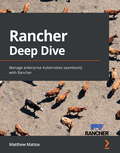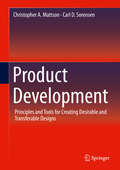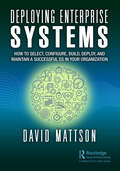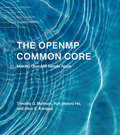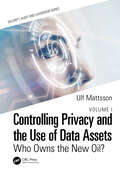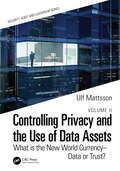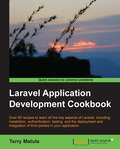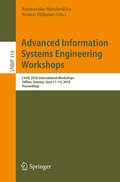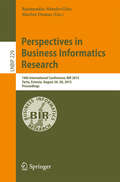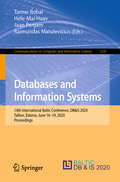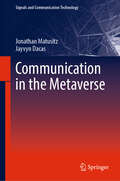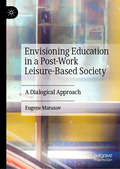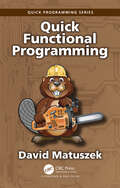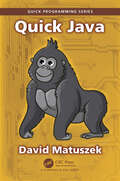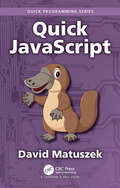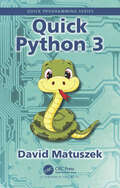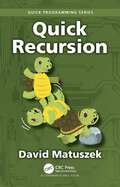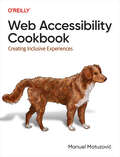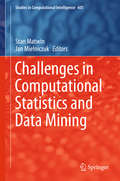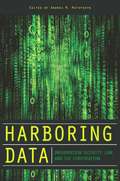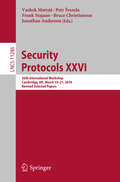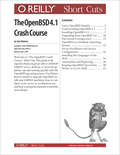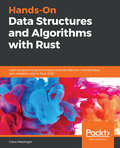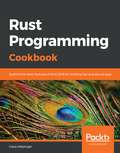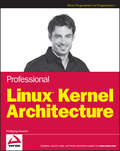- Table View
- List View
Rancher Deep Dive: Manage enterprise Kubernetes seamlessly with Rancher
by Matthew MattoxEffectively build, manage, and secure your Kubernetes workloads to implement CI/CDKey FeaturesGain a complete understanding of how Rancher worksDiscover how to design and deploy Kubernetes clusters using RancherUnderstand how to extend Kubernetes and Rancher's capabilities to take your apps to the next levelBook DescriptionKnowing how to use Rancher enables you to manage multiple clusters and applications without being locked into a vendor's platform. This book will guide you through Rancher's capabilities while deepening your understanding of Kubernetes and helping you to take your applications to a new level.The book begins by introducing you to Rancher and Kubernetes, helping you to learn and implement best practices. As you progress through the chapters, you'll understand the strengths and limitations of Rancher and Kubernetes and discover all the different ways to deploy Rancher. You'll also find out how to design and deploy Kubernetes clusters to match your requirements. The concluding chapters will show you how to set up a continuous integration and continuous deployment (CI/CD) pipeline for deploying applications into a Rancher cluster, along with covering supporting services such as image registries and Helm charts.By the end of this Kubernetes book, you'll be able to confidently deploy your mission-critical production workloads on Rancher-managed Kubernetes clusters.What you will learnDeploy Rancher in a production-ready configurationArchitect an application cluster to support mission-critical workloadsBuild the type of Kubernetes cluster that makes sense for your environmentDiscover the tools and services needed to make a new, ready-to-deploy clusterPrepare your applications to be deployed into Rancher for KubernetesExpand your Kubernetes cluster by providing additional services such as Longhorn, OPA, and monitoringWho this book is forThis book is for DevOps engineers looking to deploy Kubernetes in a fast and easy way. A basic understanding of Linux administration and containerization is needed to get the most out of this book.
Product Development: Principles and Tools for Creating Desirable and Transferable Designs
by Christopher A. Mattson Carl D. SorensenThis book explores the evolution of products from the beginning idea through mass-production. Rather than prescribing a one-size-fits-all process, the authors explain the theory behind product development and challenge readers to develop their own customized development process uniquely suited for their individual situation. In addition to theory, the book provides development case studies, exercises and self-evaluation criteria at the end of each chapter, and a product development reference that introduces a wide variety of design tools and methods. Class-tested for three consecutive years by hundreds of students in four different courses, the book is an ideal text for senior design classes in mechanical engineering and related disciplines as well as a reference for practicing engineers/product designers.
Deploying Enterprise Systems: How to Select, Configure, Build, Deploy, and Maintain a Successful ES in Your Organization
by David MattsonThis book focuses on topics that business managers and project teams in global enterprises need to understand and follow to successfully deploy an Enterprise System (ES) for their organization. It explains: Why this type of software product will appeal to global organizations with the promise to replace their older individual systems with a single integrated ES and how an ES allows companies to integrate their unique operations with a single system of many integrated modules that are designed to provide prebuilt and tested applications; New concepts, steps, risks, and methods that an organization should follow to successfully create and deploy an ES; and the top 10 reasons that ES projects fail and the practices to manage these risks. In addition, the book describes a new Implementation Model and methods to ensure success in deploying an ES across a firm with several divisions, international operations, product lines, and infrastructure. Essentially, this book: Describes, in non-technical terms, what business functions this new software product will improve Shows how an enterprise should use this software product to accomplish their goals to install and use this new technology to upgrade their older systems Explains what an organization’s management and project teams should avoid during selecting, planning, and implementing their ES to avoid common mistakes Describes the skills and experience (including IT and general management) the Project Manager must have to lead the project team(s) to implement this advanced system.
The OpenMP Common Core: Making OpenMP Simple Again (Scientific and Engineering Computation)
by Timothy G. Mattson Yun (Helen) He Alice E. KonigesHow to become a parallel programmer by learning the twenty-one essential components of OpenMP.This book guides readers through the most essential elements of OpenMP—the twenty-one components that most OpenMP programmers use most of the time, known collectively as the “OpenMP Common Core.” Once they have mastered these components, readers with no prior experience writing parallel code will be effective parallel programmers, ready to take on more complex aspects of OpenMP. The authors, drawing on twenty years of experience in teaching OpenMP, introduce material in discrete chunks ordered to support effective learning. OpenMP was created in 1997 to make it as simple as possible for applications programmers to write parallel code; since then, it has grown into a huge and complex system. The OpenMP Common Core goes back to basics, capturing the inherent simplicity of OpenMP. After introducing the fundamental concepts of parallel computing and history of OpenMP's development, the book covers topics including the core design pattern of parallel computing, the parallel and worksharing-loop constructs, the OpenMP data environment, and tasks. Two chapters on the OpenMP memory model are uniquely valuable for their pedagogic approach. The key for readers is to work through the material, use an OpenMP-enabled compiler, and write programs to experiment with each OpenMP directive or API routine as it is introduced. The book's website, updated continuously, offers a wide assortment of programs and exercises.
Controlling Privacy and the Use of Data Assets - Volume 1: Who Owns the New Oil? (Security, Audit and Leadership Series)
by Ulf Mattsson"Ulf Mattsson leverages his decades of experience as a CTO and security expert to show how companies can achieve data compliance without sacrificing operability." Jim Ambrosini, CISSP, CRISC, Cybersecurity Consultant and Virtual CISO "Ulf Mattsson lays out not just the rationale for accountable data governance, he provides clear strategies and tactics that every business leader should know and put into practice. As individuals, citizens and employees, we should all take heart that following his sound thinking can provide us all with a better future." Richard Purcell, CEO Corporate Privacy Group and former Microsoft Chief Privacy Officer Many security experts excel at working with traditional technologies but fall apart in utilizing newer data privacy techniques to balance compliance requirements and the business utility of data. This book will help readers grow out of a siloed mentality and into an enterprise risk management approach to regulatory compliance and technical roles, including technical data privacy and security issues. The book uses practical lessons learned in applying real-life concepts and tools to help security leaders and their teams craft and implement strategies. These projects deal with a variety of use cases and data types. A common goal is to find the right balance between compliance, privacy requirements, and the business utility of data. This book reviews how new and old privacy-preserving techniques can provide practical protection for data in transit, use, and rest. It positions techniques like pseudonymization, anonymization, tokenization, homomorphic encryption, dynamic masking, and more. Topics include Trends and Evolution Best Practices, Roadmap, and Vision Zero Trust Architecture Applications, Privacy by Design, and APIs Machine Learning and Analytics Secure Multiparty Computing Blockchain and Data Lineage Hybrid Cloud, CASB, and SASE HSM, TPM, and Trusted Execution Environments Internet of Things Quantum Computing And much more!
Controlling Privacy and the Use of Data Assets - Volume 2: What is the New World Currency – Data or Trust? (Security, Audit and Leadership Series)
by Ulf MattssonThe book will review how new and old privacy-preserving techniques can provide practical protection for data in transit, use, and rest. We will position techniques like Data Integrity and Ledger and will provide practical lessons in Data Integrity, Trust, and data’s business utility. Based on a good understanding of new and old technologies, emerging trends, and a broad experience from many projects in this domain, this book will provide a unique context about the WHY (requirements and drivers), WHAT (what to do), and HOW (how to implement), as well as reviewing the current state and major forces representing challenges or driving change, what you should be trying to achieve and how you can do it, including discussions of different options. We will also discuss WHERE (in systems) and WHEN (roadmap). Unlike other general or academic texts, this book is being written to offer practical general advice, outline actionable strategies, and include templates for immediate use. It contains diagrams needed to describe the topics and Use Cases and presents current real-world issues and technological mitigation strategies. The inclusion of the risks to both owners and custodians provides a strong case for why people should care. This book reflects the perspective of a Chief Technology Officer (CTO) and Chief Security Strategist (CSS). The Author has worked in and with startups and some of the largest organizations in the world, and this book is intended for board members, senior decision-makers, and global government policy officials—CISOs, CSOs, CPOs, CTOs, auditors, consultants, investors, and other people interested in data privacy and security. The Author also embeds a business perspective, answering the question of why this an important topic for the board, audit committee, and senior management regarding achieving business objectives, strategies, and goals and applying the risk appetite and tolerance. The focus is on Technical Visionary Leaders, including CTO, Chief Data Officer, Chief Privacy Officer, EVP/SVP/VP of Technology, Analytics, Data Architect, Chief Information Officer, EVP/SVP/VP of I.T., Chief Information Security Officer (CISO), Chief Risk Officer, Chief Compliance Officer, Chief Security Officer (CSO), EVP/SVP/VP of Security, Risk Compliance, and Governance. It can also be interesting reading for privacy regulators, especially those in developed nations with specialist privacy oversight agencies (government departments) across their jurisdictions (e.g., federal and state levels).
Laravel Application Development Cookbook
by Terry MatulaGet to grips with a new technology, understand what it is and what it can do for you, and then get to work with the most important features and tasks.A short and precise guide to get you started with EaselJS , helping you to create some cool applications and games.EaselJS greatly simplifies application development in HTML5 Canvas using a syntax and an architecture very similar to the ActionScript 3.0 language. As a result, Flash / Flex developers will immediately feel at home but it's very easy to learn even if you've never opened Flash in your life. The book targets Web designers, animators, Digital content producers, and Flash and Flex developers.
Advanced Information Systems Engineering Workshops: CAiSE 2018 International Workshops, Tallinn, Estonia, June 11-15, 2018, Proceedings (Lecture Notes in Business Information Processing #316)
by Raimundas Matulevičius Remco DijkmanThis book constitutes the thoroughly refereed proceedings of six international workshops held in Tallinn, Estonia, in conjunction with the 30th International Conference on Advanced Information Systems Engineering, CAiSE 2018, in June 2018. These workshops were: – The 5th Workshop on Advances in Services DEsign based on the Notion of Capability (ASDENCA) – The 1st Workshop on Business Data Analytics: Techniques and Applications (BDA) – The 1st Workshop on Blockchains for Inter-Organizational Collaboration (BIOC) – The 6thWorkshop on Cognitive Aspects of Information Systems Engineering (COGNISE) – The 2nd Workshop on Enterprise Modeling – The 1st Workshop on Flexible Advanced Information Systems (FAiSE) Two more workshops decided to produce their own, independent proceedings. The 22 full papers presented here were carefully reviewed and selected from a total of 49 submissions.
Perspectives in Business Informatics Research
by Raimundas Matulevičius Marlon DumasThis book constitutes the proceedings of the 14th International Conference on Perspectives in Business Informatics Research, BIR 2015, held in Tartu, Estonia, in August 2015. Overall, 49 submissions from 16 countries were rigorously reviewed by 47 members of the Program Committee representing 23 countries. The selected 16 full papers and 4 short papers are included in this volume. The conference theme was "making business information systems interoperable and adaptive in highly interconnected and changing contexts". The papers have been organized in topical sections on business information systems interoperability, business information system requirements and architecture, business process and decision management, business information systems development, and research in progress.
Databases and Information Systems: 14th International Baltic Conference, DB&IS 2020, Tallinn, Estonia, June 16–19, 2020, Proceedings (Communications in Computer and Information Science #1243)
by Raimundas Matulevičius Tarmo Robal Hele-Mai Haav Jaan PenjamThis book constitutes the refereed proceedings of the 14th International Baltic Conference on Databases and Information Systems, DB&IS 2020, held in Tallinn, Estonia, in June 2020.*The 22 revised papers presented were carefully reviewed and selected from 52 submissions. The papers are centered around topics like architectures and quality of information systems, artificial intelligence in information systems, data and knowledge engineering, enterprise and information systems engineering, security of information systems.*The conference was held virtully due to the COVID-19 pandemic.
Communication in the Metaverse (Signals and Communication Technology)
by Jonathan Matusitz Jayvyn DacasThis book explores the diverse methods and facets of communication in the metaverse, from interpersonal relationships to health communication, and from collaboration in the workplace to social interaction in educational contexts. More specifically, the book analyses the profound interplay between the metaverse and the larger communicative context in which it is entrenched. In this manner, the work concentrates on the factors underlying its origins, development, actualization, and popularity, as well as the fundamental discords, uncertainties, and dangers that can have serious consequences on both society and the individual. Explores diverse methods of communication in the metaverse, from interpersonal relationships to health communication; Analyses the interplay between the metaverse and the larger communicative context in which it is entrenched; Concentrates on the metaverse’s popularity and potential as well as the discords and dangers it presents.
Envisioning Education in a Post-Work Leisure-Based Society: A Dialogical Approach
by Eugene MatusovThis book is both an analytic and imaginative study of the future role of education in a leisure-based society. Grounded in a philosophical approach that draws on the work of Aristotle, Arendt, Keynes, and others, the volume deconstructs modern work-based society, as well as mainstream institutionalized education, which the author argues have systemically alienated students from their education, authorial agency, and society itself. The author argues for the value of intrinsic education, where the goals are based on students' own needs and interests, imagining new opportunities that can arise from the emergence of such a society.
Quick Functional Programming (Quick Programming)
by David MatuszekWhy learn functional programming? Isn’t that some complicated ivory-tower technique used only in obscure languages like Haskell? In fact, functional programming is actually very simple. It’s also very powerful, as Haskell demonstrates by throwing away all the conventional programming tools and using only functional programming features. But it doesn’t have to be done that way. Functional programming is a power tool that you can use in addition to all your usual tools, to whatever extent your current mainstream language supports it. Most languages have at least basic support. In this book we use Python and Java and, as a bonus, Scala. If you prefer another language, there will be minor differences in syntax, but the concepts are the same. Give functional programming a try. You may be surprised how much a single power tool can help you in your day-to-day programming.
Quick Java (Quick Programming)
by David Matuszek"We’ll be doing this next project in Java." Unfortunately, you’re a C++ programmer, or maybe a Python programmer. How are you going to get up to speed in a hurry? There are lots of Java books for beginners, telling you all about what a computer is and how it represents everything in bits. You don’t need that. At the other extreme, there are thousand-page tomes that you aren’t going to get through in a few days, if ever. You need something in-between. This book is intended to fill that gap. It’s written for the programmer who doesn’t need to be taught how to program, just how to do it in Java—and who needs to get started in a hurry. Java is covered from the inside out. First, all the things that go inside a class, most of which are practically identical to C++. After that, all the various and complicated kinds of classes and interfaces and how they relate to each other in large-scale programs. Testing is essential, so (unlike most Java books) JUnit is covered in detail. Then, in case you need to go in that direction, some functional programming, a little about parallel programming, and more than enough to get you started in building GUIs (graphical user interfaces) and doing animation. There’s a lot in this little book and, despite my best efforts, you won’t learn Java in a weekend. But it should be a good start. FEATURES Circular approach allows very fast entry into Java Full description of JUnit testing Summary of functional programming in Java Introduction to synchronization and parallel processing Extensive description of building GUIs
Quick JavaScript (Quick Programming)
by David MatuszekAre you an experienced programmer who wants to get started quickly in JavaScript and the HTML DOM? This is your book. Do you need encyclopedic knowledge of JavaScript and/or the HTML DOM? This book is not for you. Are you a novice who wants to learn to program? This book is not for you. In fact, this language is not for you. Get a good Python book. This book will get you programming in JavaScript as quickly as possible. In addition, it will provide you with a basic understanding of the Document Object Model, the massive data structure used to represent web pages. With these tools, you will be able to build interactive web pages. If you program in C++ or Java, there are parts of the book you can skip over because the JavaScript statements are exactly the same. These parts are clearly marked. JavaScript is the language—the only language—used by browsers. To create interactive web pages, you need to know both JavaScript and the DOM. This book will get you started.
Quick Python 3 (Quick Programming)
by David MatuszekAre you a programmer who wants to get started quickly in a new language? This book is for you. Are you a novice who wants to learn to program? This book is not for you. Are you a Python programmer who needs encyclopaedic information? This book is not for you. Like any mainstream language, Python has loops, if statements, assignment statements, functions, etc. I’ll show you what these look like in Python. I won’t waste your time telling you what they’re good for. Python has features you may not be familiar with--iterators, list comprehensions, maybe even dictionaries. I’ll spend more time on these. I’ll cover some of the library functions I found most immediately useful, and tell you where to find more. In short, this book will help you hit the ground running. Next week, you’ll be ready to buy that Python encyclopaedia.
Quick Recursion (Quick Programming)
by David MatuszekRecursion is the best tool for working with trees and graphs. But perhaps you’ve studied recursion and decided it’s too complicated. You just can’t think that way. That limits the kind of programming you can do. Good news! Recursion is actually easy. It’s just badly taught. See, many instructors talk about how the computer does it. They go on and on about what happens at each level of the recursion and how each level relates to other levels. The problem is that you can’t think in multiple levels. Nobody can. And you don’t have to. This book will show you how you can write recursive programs. Once you understand a few simple rules, you will wonder why you ever thought recursion was complicated. You’ll be able to write recursive programs quickly and easily. Well, as quick and easy as programming ever is, anyway.
Web Accessibility Cookbook
by Manuel MatuzovicFrontend developers have to consider many things: browser compatibility, usability, performance, scalability, SEO, and other best practices. But the most fundamental aspect of creating websites is one that often falls short: accessibility. Accessibility is the cornerstone of any website, and if a website is inaccessible, users won't be able to interact with it, obtain information, sign up for services, or buy products.The Web Accessibility Cookbook provides you with dozens of recipes to help you avoid these failures. You'll learn how to build common components, such as main navigation, filters, and dialogs, in an accessible manner. Each recipe not only explains how to build things but also why. Author Manuel Matuzovic provides the knowledge you need to create your own accessible components and address your users' varying needs, abilities, and preferences.With this practical guide, you will:Learn how to build websites that feature inclusive frontendsDiscover the common obstacles website users face every dayUnderstand how your decisions impact usersLearn how to build accessible frontends step-by-stepWrite high-quality markup and CSSEvaluate the accessibility of frontend components
Challenges in Computational Statistics and Data Mining (Studies in Computational Intelligence #605)
by Stan Matwin Jan MielniczukThis volume contains nineteen research papers belonging to the areas of computational statistics, data mining, and their applications. Those papers, all written specifically for this volume, are their authors' contributions to honour and celebrate Professor Jacek Koronacki on the occcasion of his 70th birthday. The book's related and often interconnected topics, represent Jacek Koronacki's research interests and their evolution. They also clearly indicate how close the areas of computational statistics and data mining are.
Harboring Data
by Andrea M. MatwyshynMatwyshyn (legal studies and business ethics, U. of Pennsylvania) compiles 10 articles by law and other scholars, information security professionals, and other experts from the US, UK, Canada, and Hong Kong on the business, legal, and social dynamics affecting corporate information security and data breaches. They discuss the need to adopt a multidisciplinary lens in analyzing information security; public aspects of corporate information security; protecting intellectual property assets; health, financial, and children's data, including HIPAA regulations; and changing contract law norms and new business models in social networking websites. Annotation c2010 Book News, Inc. , Portland, OR (booknews. com)
Security Protocols XXVI: 26th International Workshop, Cambridge, UK, March 19–21, 2018, Revised Selected Papers (Lecture Notes in Computer Science #11286)
by Vashek Matyáš Petr Švenda Frank Stajano Bruce Christianson Jonathan AndersonThis book constitutes the thoroughly refereed post-workshop proceedings of the 26th International Workshop on Security Protocols, held in Cambridge, UK, in March 2018. The volume consists of 17 thoroughly revised invited papers presented together with the respective transcripts of discussions. The theme of this year's workshop was fail-safe and fail-deadly concepts in protocol design. The topics covered included failures and attacks; novel protocols; threat models and incentives; cryptomoney; and the interplay of cryptography and dissent.
The OpenBSD 4.0 Crash Course
by Jem MatzanOpenBSD is a Unix-like computer operating system that is widely regarded for its excellent documentation and its fanatical focus on security. "The OpenBSD Crash Course" Short Cut will help you get an x86 or AMD64/EM64T server, desktop, or network appliance up and running quickly with OpenBSD. You'll learn how to install or upgrade OpenBSD on x86 and AMD64 machines, how to configure it for server or workstation use, and how to properly maintain it until the next release.
Hands-On Data Structures and Algorithms with Rust: Learn programming techniques to build effective, maintainable, and readable code in Rust 2018
by Claus MatzingerDesign and implement professional level programs by exploring modern data structures and algorithms in Rust. Key Features Use data structures such as arrays, stacks, trees, lists and graphs with real-world examples Learn the functional and reactive implementations of the traditional data structures Explore illustrations to present data structures and algorithms, as well as their analysis, in a clear, visual manner. Book Description Rust has come a long way and is now utilized in several contexts. Its key strengths are its software infrastructure and resource-constrained applications, including desktop applications, servers, and performance-critical applications, not forgetting its importance in systems' programming. This book will be your guide as it takes you through implementing classic data structures and algorithms in Rust, helping you to get up and running as a confident Rust programmer. The book begins with an introduction to Rust data structures and algorithms, while also covering essential language constructs. You will learn how to store data using linked lists, arrays, stacks, and queues. You will also learn how to implement sorting and searching algorithms. You will learn how to attain high performance by implementing algorithms to string data types and implement hash structures in algorithm design. The book will examine algorithm analysis, including Brute Force algorithms, Greedy algorithms, Divide and Conquer algorithms, Dynamic Programming, and Backtracking. By the end of the book, you will have learned how to build components that are easy to understand, debug, and use in different applications. What you will learn Design and implement complex data structures in Rust Analyze, implement, and improve searching and sorting algorithms in Rust Create and use well-tested and reusable components with Rust Understand the basics of multithreaded programming and advanced algorithm design Become familiar with application profiling based on benchmarking and testing Explore the borrowing complexity of implementing algorithms Who this book is for This book is for developers seeking to use Rust solutions in a practical/professional setting; who wants to learn essential Data Structures and Algorithms in Rust. It is for developers with basic Rust language knowledge, some experience in other programming languages is required.
Rust Programming Cookbook: Explore the latest features of Rust 2018 for building fast and secure apps
by Claus MatzingerPractical solutions to overcome challenges in creating console and web applications and working with systems-level and embedded code, network programming, deep neural networks, and much more. Key Features Work through recipes featuring advanced concepts such as concurrency, unsafe code, and macros to migrate your codebase to the Rust programming language Learn how to run machine learning models with Rust Explore error handling, macros, and modularization to write maintainable code Book Description Rust 2018, Rust's first major milestone since version 1.0, brings more advancement in the Rust language. The Rust Programming Cookbook is a practical guide to help you overcome challenges when writing Rust code. This Rust book covers recipes for configuring Rust for different environments and architectural designs, and provides solutions to practical problems. It will also take you through Rust's core concepts, enabling you to create efficient, high-performance applications that use features such as zero-cost abstractions and improved memory management. As you progress, you'll delve into more advanced topics, including channels and actors, for building scalable, production-grade applications, and even get to grips with error handling, macros, and modularization to write maintainable code. You will then learn how to overcome common roadblocks when using Rust for systems programming, IoT, web development, and network programming. Finally, you'll discover what Rust 2018 has to offer for embedded programmers. By the end of the book, you'll have learned how to build fast and safe applications and services using Rust. What you will learn Understand how Rust provides unique solutions to solve system programming language problems Grasp the core concepts of Rust to develop fast and safe applications Explore the possibility of integrating Rust units into existing applications for improved efficiency Discover how to achieve better parallelism and security with Rust Write Python extensions in Rust Compile external assembly files and use the Foreign Function Interface (FFI) Build web applications and services using Rust for high performance Who this book is for The Rust cookbook is for software developers looking to enhance their knowledge of Rust and leverage its features using modern programming practices. Familiarity with Rust language is expected to get the most out of this book.
Professional Linux Kernel Architecture
by Wolfgang MauererFind an introduction to the architecture, concepts and algorithms of the Linux kernel in Professional Linux Kernel Architecture, a guide to the kernel sources and large number of connections among subsystems. Find an introduction to the relevant structures and functions exported by the kernel to userland, understand the theoretical and conceptual aspects of the Linux kernel and Unix derivatives, and gain a deeper understanding of the kernel. Learn how to reduce the vast amount of information contained in the kernel sources and obtain the skills necessary to understand the kernel sources.
